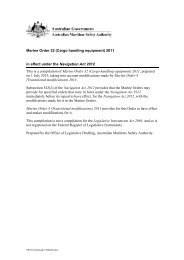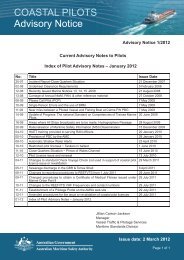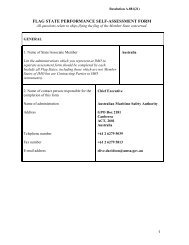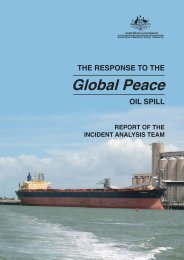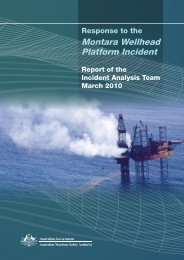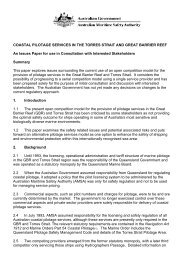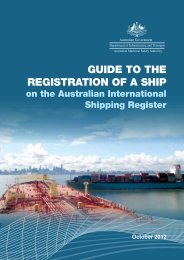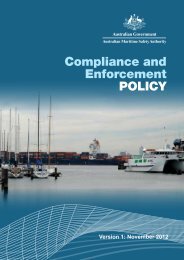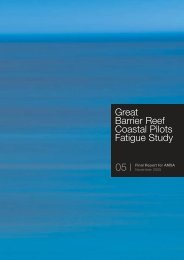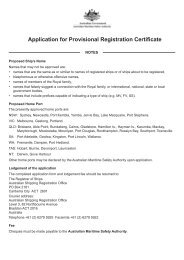Coastal pilotage regulation review - Australian Maritime Safety ...
Coastal pilotage regulation review - Australian Maritime Safety ...
Coastal pilotage regulation review - Australian Maritime Safety ...
You also want an ePaper? Increase the reach of your titles
YUMPU automatically turns print PDFs into web optimized ePapers that Google loves.
AMSA – <strong>Coastal</strong> Pilotage Regulation ReviewUnfortunately, there was no simple “heads up” from others on the bridge andgroundings followed. This was identified in the <strong>Australian</strong> Transport <strong>Safety</strong> Bureau(ATSB) reports as a failure to properly implement Bridge Resource Management,(BRM).5.16 Many pilots interviewed pointed to the variable standards in skills, knowledge andability of both watchkeepers and masters as a reason not to bother with BRM. Yet thesame vessels, with the same crews, go to all ports in the Commonwealth – Pilotservices in Brisbane, Sydney, Fremantle and Melbourne are jointly developing andimplementing procedures to actively involve the bridge team in the <strong>pilotage</strong> of thevessel, whatever the individual standard of the members of the team. This is the firstdefence against the consequences of pilot error. How and whether it is implementedshould not be left to the individual pilot no matter what his opinion of the bridge team’sabilities are. The provider should develop and implement standard procedures to ensurethe bridge team is involved in the navigation of the vessel. It is surely insufficient torecognize the problem and a solution and then adopt the attitude that it will not workbecause some members of the bridge team are useless. From time to time suggestionsare made that 2 pilots are carried to allow for periods of rest – however, in developingprocedures, consideration could perhaps be given to the role the vessel’s master mightplay, in order to allow 2 people on the bridge at all times.5.17 It has been held that a good <strong>pilotage</strong> plan is central to the safety of the <strong>pilotage</strong>operation. Whilst this proposition was generally agreed, agreement was not unanimous,with one pilot stating that a passage plan was “all rubbish and required just to satisfybureaucrats at the IMO”. Given that this one view of a plan may be considered extreme,it was noted and ignored by the <strong>review</strong>. Involvement of the bridge team would beassisted by standard operating procedures (SOP’s), standard check lists, standard plansetc. Uniform procedures reduce risk of error. This has been the experience of otherpilot services. It has also been the experience in many organisations (e.g. airlines,hospitals, power stations) who wish to effectively manage risk. One pilot interviewedsaid he emailed his plan 2 days in advance to the ship, so that meaningful discussioncould take place and the plan be amended as necessary. This seems like a good idea. Ifit is, it should be capable of adoption by all pilots. Pilots have a variety of methods andideas. Facilitation of discussion about methods and techniques and the adoption of‘good ideas’ is the responsibility of the provider under the GBRSMC. It is part andparcel of an effective SMS.5.18 Most pilots appear to make use of a lap top computer combined with GPS in theirconduct of the <strong>pilotage</strong> operation. It is another aid to assist navigation and is used withother aids and methods. It can also be combined with an alarm system to warn ofdeviations from the plan. The alarm can (and is) set during a pilot’s necessary absencesfrom the bridge for sleep etc as well as when he has conduct of the vessel. If unplanneddeviations occur, the pilot and watchkeeper may be warned and corrective action cantake place. This is another line of defence against error. The issue is why such adefence is not used by all pilots? The effective use of the device requires a protocol tobe developed incorporating defined procedures (an SOP) to be followed by all pilots.Once again there appears to be a role for the provider as part of the SMS.5.19 The attitude of pilots to REEFCENTRE varies. Two written submissions suggested thatit was unnecessary and should be closed down because traffic information could beJohn McCoy Created on 4 Dec 2005 Page 17 of 34



